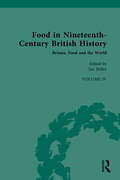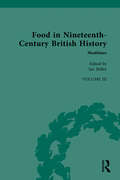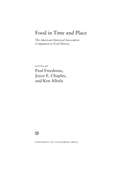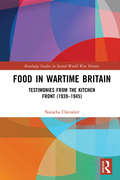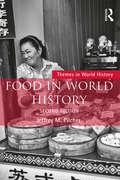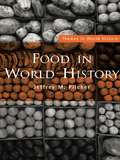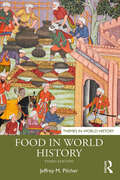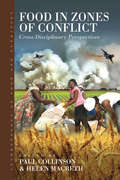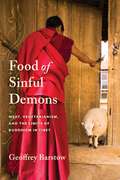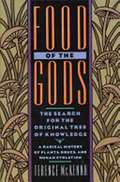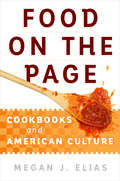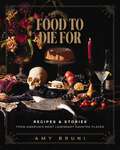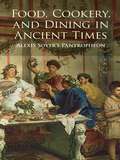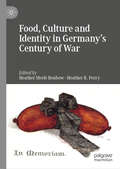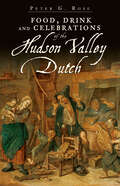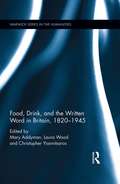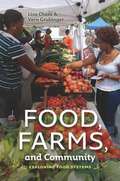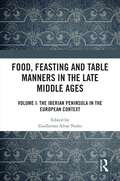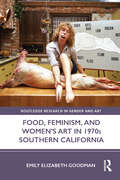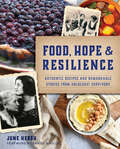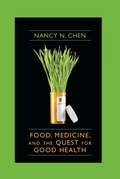- Table View
- List View
Food in Nineteenth-Century British History: Volume IV: Britain, Food and the World (Nineteenth-Century Science, Technology and Medicine: Sources and Documents)
by Ian MillerVolume 4 examines the British diet from its colonial and global perspectives. Colonialism, combined with rapidly improving global transport networks, introduced the British introduced to a plethora of unfamiliar foods from overseas. Changing economic trading patterns also impacted massively on the changing British diet. Emigration (inwards and outwards), and military service, further encouraged a global inter-mingling of diets and palates. The British stomach was introduced to new spices and herbs, either at home or abroad, although fears persisted that the British constitution was ill-suited to rich, foreign foods. A selection of sources will bring to life how the increasingly globalised world changed British eating habits, while introducing readers to the many debates surrounding this transition.
Food in Nineteenth-Century British History: Volume Three: Mealtimes (Nineteenth-Century Science, Technology and Medicine: Sources and Documents)
by Ian MillerA curious phenomenon occurred in British food writing from around the 1860s. Publishers began printing books dedicated to specific meals. Breakfast. Luncheons. Afternoon Tea. Dinners. Until this time, most cookbooks had been hefty tomes containing hundreds of pages of recipes, but the new recipe books were slimmer and more accessible, catering for a broader readership. The appearance of focused cookbooks reveals the growing influence of advanced printing technologies and rising literacy levels combined with changes in social life and class relations that coalesced around food, granting mealtimes great importance. The sources reprinted in this volume were produced in response to the changing social dynamics that accompanied industrialisation, urbanisation and socio-economic modernisation.
Food in Time and Place
by Ken Albala Joyce E. Chaplin Paul FreedmanFood and cuisine are important subjects for historians across many areas of study. Food, after all, is one of the most basic human needs and a foundational part of social and cultural histories. Such topics as famines, food supply, nutrition, and public health are addressed by historians specializing in every era and every nation.Food in Time and Place delivers an unprecedented review of the state of historical research on food, endorsed by the American Historical Association, providing readers with a geographically, chronologically, and topically broad understanding of food cultures--from ancient Mediterranean and medieval societies to France and its domination of haute cuisine. Teachers, students, and scholars in food history will appreciate coverage of different thematic concerns, such as transfers of crops, conquest, colonization, immigration, and modern forms of globalization.
Food in Wartime Britain: Testimonies from the Kitchen Front (1939–1945) (Routledge Studies in Second World War History)
by Natacha ChevalierBased on deep analysis of Mass Observation wartime diaries, Food in Wartime Britain explores the food experience of the British middle classes in their own words throughout the course of the Second World War. It reveals that, while the food practices of the population were modified by rationing and food scarcity, social class and personal circumstances were key dimensions of the wartime food experience that demand to be taken into account in the historical narrative of the Home Front.
Food in World History
by Jeffrey M. PilcherThe second edition of this concise survey offers a comparative and comprehensive study of culinary cultures and food politics throughout the world, from ancient times to the present day. It examines the long history of globalization of foods as well as the political, social, and environmental implications of our changing relationship with food, showing how hunger and taste have been driving forces in human history.? Including numerous case studies from diverse societies and periods, Food in World History explores such questions as: What social factors have historically influenced culinary globalization? How did early modern plantations establish patterns for modern industrial food production? Were eighteenth-century food riots comparable to contemporary social movements around food? Did Italian and Chinese migrant cooks sacrifice authenticity to gain social acceptance in the Americas? Have genetically modified foods fulfilled the promises made by proponents? This new edition includes expanded discussions of gender and the family, indigeneity, and the politics of food. Expanded chapters on contemporary food systems and culinary pluralism examine debates over the concentration of corporate control over seeds and marketing, authenticity and exoticism within the culinary tourism industry, and the impact of social media on restaurants and home cooks.
Food in World History (Themes in World History)
by Jeffrey M. PilcherProviding a comparative and comprehensive study of culinary cultures and consumption throughout the world from ancient times to present day, this book examines the globalization of food and explores the political, social and environmental implications of our changing relationship with food. Including numerous case studies from diverse societies and periods, Food in World History examines and focuses on: how food was used to forge national identities in Latin America the influence of Italian and Chinese Diaspora on the US and Latin America food culture how food was fractured along class lines in the French bourgeois restaurant culture and working class cafes the results of state intervention in food production how the impact of genetic modification and food crises has affected the relationship between consumer and product. This concise and readable survey not only presents a simple history of food and its consumption, but also provides a unique examination of world history itself.
Food in World History (Themes in World History)
by Jeffrey M. PilcherNow in its third edition, Food in World History explores culinary cultures and food politics throughout the world, from ancient times to the present day, with expanded discussions of industrialization, indigeneity, colonialism, gender, environment, and food and power. It examines the long history of globalization of foods as well as the political, social, and environmental implications of our changing relationship with food, showing how hunger and taste have been driving forces in human history. Including numerous case studies from diverse societies and periods, such as Maya and Inca cuisines and peasant agriculture in the early modern era, Food in World History explores such questions as: What social factors have historically influenced culinary globalization? How did early modern plantations establish patterns for modern industrial food production? How will the climate crisis affect food production and culinary cultures? Did Italian and Chinese migrant cooks sacrifice authenticity to gain social acceptance in the Americas? Have genetically modified foods fulfilled the promises made by proponents? With the inclusion of more global examples, this comprehensive survey is an ideal resource for all students who study food history or food studies.
Food in Zones of Conflict: Cross-Disciplinary Perspectives (Anthropology of Food & Nutrition #8)
by Helen Macbeth Paul CollinsonThe availability of food is an especially significant issue in zones of conflict because conflict nearly always impinges on the production and the distribution of food, and causes increased competition for food, land and resources Controlling the production of and access to food can also be used as a weapon by protagonists in conflict. The logistics of supply of food to military personnel operating in conflict zones is another important issue. These themes unite this collection, the chapters of which span different geographic areas. This volume will appeal to scholars in a number of different disciplines, including anthropology, nutrition, political science, development studies and international relations, as well as practitioners working in the private and public sectors, who are currently concerned with food-related issues in the field.
Food in the Making of Modern Korea: A Handbook
by Cherl-Ho LeeThis handbook offers an updated and comprehensive presentation of knowledge on Korean modern and contemporary food history. It covers the changes in food availability, nutrition, and the health status of Koreans, and the Korean food industry's development from the late period of Joseon dynasty in the mid-19th century, to the present. This period includes the severe poverty and food shortage of the Joseon dynasty, followed by the Japanese invasion, Independence and the South-North division, the Korean war, and rapid industrial development. The influence of national and international environments and political changes during the last 150 years on the Korean food security and the nutritional situation of the people is demarcated. In doing so, the author makes novel suggestions on possible contributions to alleviate the world food crisis in the future. Relevant to food historians and food scientists, and East Asian studies scholars with a particular interest in Korean culture and history,this is a pioneering work that elucidates the driving forces for the development and betterment of Korean society—through food acquisition.
Food of Sinful Demons: Meat, Vegetarianism, and the Limits of Buddhism in Tibet (Studies of the Weatherhead East Asian Institute, Columbia University)
by Geoffrey BarstowTibetan Buddhism teaches compassion toward all beings, a category that explicitly includes animals. Slaughtering animals is morally problematic at best and, at worst, completely incompatible with a religious lifestyle. Yet historically most Tibetans—both monastic and lay—have made meat a regular part of their diet. In this study of the place of vegetarianism within Tibetan religiosity, Geoffrey Barstow explores the tension between Buddhist ethics and Tibetan cultural norms to offer a novel perspective on the spiritual and social dimensions of meat eating.Food of Sinful Demons shows the centrality of vegetarianism to the cultural history of Tibet through specific ways in which nonreligious norms and ideals shaped religious beliefs and practices. Barstow offers a detailed analysis of the debates over meat eating and vegetarianism, from the first references to such a diet in the tenth century through the Chinese invasion in the 1950s. He discusses elements of Tibetan Buddhist thought—including monastic vows, the Buddhist call to compassion, and tantric antinomianism—that see meat eating as morally problematic. He then looks beyond religious attitudes to examine the cultural, economic, and environmental factors that oppose the Buddhist critique of meat, including Tibetan concepts of medicine and health, food scarcity, the display of wealth, and idealized male gender roles. Barstow argues that the issue of meat eating was influenced by a complex interplay of factors, with religious perspectives largely supporting vegetarianism while practical concerns and secular ideals pulled in the other direction. He concludes by addressing the surge in vegetarianism in contemporary Tibet in light of evolving notions of Tibetan identity and resistance against the central Chinese state. The first book to discuss this complex issue, Food of Sinful Demons is essential reading for scholars interested in Tibetan religion, history, and culture as well as global food history.
Food of the Gods: The Search for the Original Tree of Knowledge a Radical History of Plants, Drugs, and Human Evolution
by Terence McKennaAn exploration of humans' symbiotic relationships with plants and chemicals presents information on prehistoric partnership societies, the roles of spices and spirits in the rise of dominator societies; and the politics of tobacco, tea, coffee, opium, and alcohol. <p><p> Why, as a species, are humans so fascinated by altered states of consciousness? Can altered states reveal something to us about our origins and our place in nature? In Food of the Gods, ethnobotanist Terence McKenna's research on man's ancient relationship with chemicals opens a doorway to the divine, and perhaps a solution for saving our troubled world. McKenna provides a revisionist look at the historical role of drugs in the East and the West, from ancient spice, sugar, and rum trades to marijuana, cocaine, synthetics, and even television--illustrating the human desire for the "food of the gods" and the powerful potential to replace abuse of illegal drugs with a shamanic understanding, insistence on community, reverence for nature, and increased self-awareness.
Food on the Page: Cookbooks and American Culture
by Megan J. EliasWhat is American food? From barbecue to Jell-O molds to burrito bowls, its history spans a vast patchwork of traditions, crazes, and quirks. A close look at these foods and the recipes behind them unearths a vivid map of American foodways: how Americans thought about food, how they described it, and what foods were in and out of style at different times.In Food on the Page, the first comprehensive history of American cookbooks, Megan J. Elias chronicles cookbook publishing from the early 1800s to the present day. Following food writing through trends such as the Southern nostalgia that emerged in the late nineteenth century, the Francophilia of the 1940s, countercultural cooking in the 1970s, and today's cult of locally sourced ingredients, she reveals that what we read about food influences us just as much as what we taste.Examining a wealth of fascinating archival material—and rediscovering several all-American culinary delicacies and oddities in the process—Elias explores the role words play in the creation of taste on both a personal and a national level. From Fannie Farmer to The Joy of Cooking to food blogs, she argues, American cookbook writers have commented on national cuisine while tempting their readers to the table. By taking cookbooks seriously as a genre and by tracing their genealogy, Food on the Page explains where contemporary assumptions about American food came from and where they might lead.
Food to Die For: Recipes and Stories from America's Most Legendary Haunted Places
by Amy BruniDiscover tantalizing recipes, spine-tingling stories, and historic photos from the most notoriously haunted locations across America in this fun and fascinating cookbook. Paranormal investigator and Kindred Spirits co-host Amy Bruni leads you through eerie hotels, haunted homes, hellish hospitals, and spooky ghost towns, giving you stories and a recipe from each place.Whether you're in the mood for Lizzie Borden's meatloaf or want to serve up spooky prison stories along with sugar cookies from Alcatraz, Food to Die For is your guide to ghoulish gastronomy.One of America's favorite ghost hunters, Amy Bruni takes you to mysterious hotels, eerie ghost towns, and possessed pubs in this delightfully sinister collection of stories and recipes. Each of the nearly 60 locations in Food to Die For includes:Vintage photographs and charmingly creepy stories rooted in historyA noteworthy recipe associated with the people or placeFull-color, captivating, and hauntingly styled food photos to inspire a killer kitchen experience Enjoy creepy recipes like:Southern Fried Chicken from the Missouri State PenitentiarySheboygan Asylum Caesar SaladCornbread inspired by the Villisca Axe Murder HouseAbsinthe Frappé from the Old Absinthe HouseErnest Hemingway's Bloody Mary from Hemingway Home & MuseumVegetable Soup from Waverly Hills Sanatorium This terrifyingly tasty cookbook will bewitch anyone who:Has a taste for the paranormal and a hunger to try new foodsLoves history, travel, and culinary curiositiesEnjoys entertaining guests in unique and memorable waysWould get goosebumps making a recipe written 300 years ago History buffs, thrill-seekers, and foodies will all get shivers seeing the past come to life with every enchanted recipe and delicious tale from Food to Die For.
Food, Cookery, and Dining in Ancient Times: Alexis Soyer's Pantropheon
by Alexis Soyer"Tell me what thou eatest," Alexis Soyer declared in a familiar refrain, "and I will tell thee who thou art." In his book Pantropheon, originally published in 1853, the flamboyant Frenchman (and world's first celebrity chef) ventures to answer that question as he presents a wealth of entertaining and enlightening information on what food the people of ancient civilizations ate and how they prepared it.Describing the culinary achievements of the Greeks, Romans, Assyrians, Egyptians, and Jews, Soyer covers such topics as the mythological origin of specific foods (pomegranates and eels, for example); agricultural, milling, and marketing practices; descriptions of seasonings, pastries, and exotic dishes; the treatment of dinner guests; as well as suggestions for serving pigeon, peacock, wild boar, camel, elephant, flamingo, and other wildlife.Enhanced by 38 illustrations depicting food-related objects and antiquity's gastronomic wonders, this witty and literal study of epicurean delights will charm history buffs and food enthusiasts alike.
Food, Culture and Identity in Germany's Century of War
by Heather Merle Benbow Heather R. PerryEven in the harsh conditions of total war, food is much more than a daily necessity, however scarce—it is social glue and an identity marker, a form of power and a weapon of war. This collection examines the significance of food and hunger in Germany’s turbulent twentieth century. Food-centered perspectives and experiences “from below” reveal the social, cultural and political consequences of three conflicts that defined the twentieth century: the First and Second World Wars and the ensuing global Cold War. Emerging and established scholars examine the analytical salience of food in the context of twentieth-century Germany while pushing conventional temporal frameworks and disciplinary boundaries. Together, these chapters interrogate the ways in which deeper studies of food culture in Germany can shed new light on old wars.
Food, Drink and Celebrations of the Hudson Valley Dutch (American Palate)
by Peter G RoseThe renowned food historian delves into the early culinary traditions of Dutch settlers in New York state and their influence on the American kitchen.In 1609, Henry Hudson, under contract with the Dutch East India Company, set out to discover the lucrative Northwest Passage. The Hudson River Valley is what he discovered instead, and along its banks Dutch culture took hold. While the Dutch influence can still be seen in local architecture and customs, it is food and drink that Peter Rose has made her life&’s work. From beer to bread and cookies to coleslaw, Food, Drink and Celebrations of the Hudson Valley Dutch is a comprehensive look at this important early American influence, complete with recipes to try.
Food, Drink, and the Written Word in Britain, 1820-1945 (Warwick Series in the Humanities)
by Laura Wood Mary Addyman Christopher YiannitsarosThis volume explores the intersection between culinary history and literature across a period of profound social and cultural change. Split into four parts, essays focus on the relationships between eating and childhood reading in the Victorian era, the role of hunger in depicting social instability and reform, the cultivation of taste through advertising and the formation of cultural legacies through imaginative and emotional experiences of food and drink. Contributors show that studying consumption is necessary for a full understanding of class, gender, national identity and the body. The works of writers such as Elizabeth Gaskell, Edward Lear, Isabella Beeton and Bram Stoker are considered alongside advice manuals, Home Front narratives and advertising to provide an innovative work that will be of interest to scholars of social, cultural and medical history as well as literary studies.
Food, Energy and the Creation of Industriousness
by Craig Muldrew"Until the widespread harnessing of machine energy, food was the energy which fuelled the economy. In this groundbreaking study of agricultural labourers' diet and material standard of living Craig Muldrew uses new empirical research to present a much fuller account of the interrelationship between consumption, living standards and work in the early modern English economy than has previously existed. The book integrates labourers into a study of the wider economy and engages with the history of food as an energy source and its importance to working life, the social complexity of family earnings and the concept of the 'industrious revolution'. It argues that 'industriousness' was as much the result of ideology and labour markets as labourers' household consumption. Linking this with ideas about the social order of early modern England the author demonstrates that bread, beer and meat were the petrol of this world and a springboard for economic change"--
Food, Farms, and Community: Exploring Food Systems
by Lisa Chase Vern GrubingerThroughout the United States, people are increasingly concerned about where their food comes from, how it is produced, and how its production affects individuals and their communities. The answers to these questions reveal a complex web of interactions. While large, distant farms and multinational companies dominate at national and global levels, innovative programs including farmers' markets, farm-to-school initiatives, and agritourism are forging stronger connections between people and food at local and regional levels. At all levels of the food system, energy use, climate change, food safety, and the maintenance of farmland for the future are critical considerations. The need to understand food systems--what they are, who's involved, and how they work (or don't)--has never been greater. Food, Farms, and Community: Exploring Food Systems takes an in-depth look at critical issues, successful programs, and challenges for improving food systems spanning a few miles to a few thousand miles. Case studies that delve into the values that drive farmers, food advocates, and food entrepreneurs are interwoven with analysis supported by the latest research. Examples of entrepreneurial farms and organizations working together to build sustainable food systems are relevant to the entire country--and reveal results that are about much more than fresh food.
Food, Feasting and Table Manners in the Early Renaissance: Volume II: From the Iberian Peninsula towards a New World
by Guillermo Alvar NuñoThe acquisition of table manners and rhetorical skills, the interaction between medicine and eating, and the presence of food in literature and religion shaped Peninsular societies and connected them to a Western European background during the Middle Ages. The Renaissance, however, marked a turning point in world history, and the reader will learn how eating evolved in the kingdoms of Spain and Portugal during the early Renaissance in fields such as morals, politics, medicine, literature and religion. The book also explains how the cultural conception of food was exported by Iberian explorers to the Americas and Japan.The present volume focuses on a two-fold issue: food as a cultural element that united Mediterranean European society, and food as a cultural encounter between European explorers and new worlds during the early Renaissance. Therefore, this volume continues the themes introduced in the previous monograph, Food, Feasting and Table Manners in the Late Middle Ages: Volume I: The Iberian Peninsula in the European Context, but takes into account the new, global scale of the era.Readers will find here a panorama of what, and how, people ate in Mediterranean Europe during the fifteenth and sixteenth centuries and learn how cultural aspects of food were exported to the new lands that were explored during the Age of Discovery.
Food, Feasting and Table Manners in the Late Middle Ages: Volume I: The Iberian Peninsula in the European Context
by Guillermo Alvar NuñoThis book offers a study of what and how people ate in the Iberian Peninsula between the twelfth and fifteenth centuries. It has long been recognized that Mediterranean cultures attach great importance to communal meals and food cooked with great refinement. However, whilst medieval feasting in England, France and Italy has been thoroughly studied, Spain and Portugal have both been somewhat neglected in this area of study. This volume analyses how medieval men of the Iberian Peninsula questioned themselves about different aspects deemed important in social feasting. It investigates the acquisition of table manners and rhetorical skills, the interaction between medicine and eating, and the presence of food in literature and religion. The book also shows how this shared society and culture, as well as their attitude towards food, connected them to a Western European tradition. The book will appeal to scholars and students alike interested in food and feasting from the perspectives of literature, history, language, art, religion and medicine, and to those interested in a social, cultural and literary overview of life in the Iberian Peninsula during the late Middle Ages.
Food, Feminism, and Women’s Art in 1970s Southern California (Routledge Research in Gender and Art)
by Emily Elizabeth GoodmanThis book explores how feminist artists continued to engage with kitchen culture and food practices in their work as women’s art moved from the margins to the mainstream. In particular, this book examines the use of food in the art practices of six women artists and collectives working in Southern California—a hotbed of feminist art in the 1970s—in conjunction with the Women’s Art Movement and broader feminist groups during the era of the Second Wave. Focused around particular articulations of food in culture, this book considers how feminist artists engage with issues of gender, labor, class, consumption, (re)production, domesticity, and sexuality in order to advocate for equality and social change. The book will be of interest to scholars working in art history, food studies, and gender and women’s studies.
Food, Feminism, and Women’s Art in 1970s Southern California (Routledge Research in Gender and Art)
by Emily Elizabeth GoodmanThis book explores how feminist artists continued to engage with kitchen culture and food practices in their work as women’s art moved from the margins to the mainstream.In particular, this book examines the use of food in the art practices of six women artists and collectives working in Southern California—a hotbed of feminist art in the 1970s—in conjunction with the Women’s Art Movement and broader feminist groups during the era of the Second Wave. Focused around particular articulations of food in culture, this book considers how feminist artists engage with issues of gender, labor, class, consumption, (re)production, domesticity, and sexuality in order to advocate for equality and social change.The book will be of interest to scholars working in art history, food studies, and gender and women’s studies.
Food, Hope & Resilience: Authentic Recipes and Remarkable Stories from Holocaust Survivors (American Palate)
by June HershCulinary Traditions Preserved, Stories Never to be Forgotten This vital collection of survivor stories uplifts and inspires alongside recipes that nourish your soul. Read about daring partisans who fought in the woods, hidden children who sought comfort from strangers and those who endured unimaginable internment. For Holocaust survivors, food was a way to connect their lives before the war with the homes they created after. Their kitchens were filled with the aromas of familiar foods like chicken soup and brisket while unfamiliar delights they adopted, like arroz con pollo and gnocchi, became part of their repertoire. These are the recipes they share with you. Culinary icons such as Michael Solomonov, Jonathan Waxman, Ina Garten and more contribute their own recipes as tribute to the remarkable survivor community. Author June Hersh gives readers a taste of history and a life-affirming message that honors the legacy of Holocaust survivors. A portion of the proceeds from sales of this book will benefit organizations committed to Holocaust education.
Food, Medicine, and the Quest for Good Health
by Chen Nancy N.Drawing on medical texts and food therapy practices from around the world and throughout history, Nancy N. Chen locates old and new crossovers between food and medicine in different social and cultural contexts.
